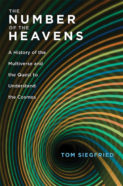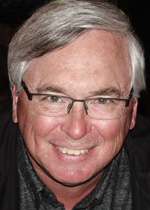
The Number of the Heavens
Tom Siegfried
Harvard Univ., $29.95
There is no bigger question than whether the universe is all there is.
Scientists are juggling several ideas for what a multiverse, if one exists, might be like. Our universe could be one bubble in a vast cosmic fizz. Or one of many 3-D domains stacked, like pages of a book, in higher dimensional space. Or one series of events that continually branches off from other histories in a tree of alternate realities. All these possibilities, while tantalizing, remain unconfirmed.
The prospect of many universes has intrigued scholars for millennia — and has evolved to mean different things, as humankind’s concept of the universe has zoomed out from a single solar system to a galaxy to a great cosmic web.
“The multiverse debate is like a long-running TV series with new characters replacing the old ones,” science journalist Tom Siegfried, a former editor in chief of Science News and current contributing correspondent, writes in The Number of the Heavens. His new book is a recap of that age-old discourse.
Each rendition of the multiverse debate has revisited common themes, including whether science has any business speculating about unobservable realms. Each iteration has had its believers and its naysayers. But those curious minds have been united in their common fascination with one of the most profound mysteries of all time: What is the entirety of existence?
Science News spoke with Siegfried about what we can learn from past generations of multiverse debates and how scientists might determine whether a multiverse exists. The following conversation has been edited for length and clarity.
SN: Were there any historical details that caught you by surprise?
 Courtesy of T. Siegfried
Courtesy of T. SiegfriedSiegfried: I hadn’t appreciated the extent to which the multiverse had been an issue in ancient Greece. The atomists were the ancient Greeks known for suggesting the existence of atoms, which was contrary to what the prevailing views were. I wasn’t aware that the atomists had also been such advocates for the multiplicity of universes. Their belief that the universe had been made of atoms required an infinite number of atoms, and if there were an infinite number of atoms that you needed to make that structure, then there would be an infinite number of atoms left to make other universes.
SN: Are there ways to test any of the modern conceptions of the multiverse?
Siegfried: They might be long shots, but it’s not impossible. If there are other [bubble universes] out there, it is conceivable that one of those bubbles could collide with our bubble and imprint on the cosmic microwave background radiation in space to reveal that.
But the main point that people overlook is, the multiverse is not a theory. The multiverse is a prediction of other theories [such as superstring theory] that can be tested in other ways. If you have a theory that makes many testable predictions that turn out to be right, that implies the existence of other things the theory predicts. Atoms could not be observed directly for [about] 2,500 years. But they were nevertheless inferred to exist by things that could be observed. The multiverse could be the same way.
SN: You recount how, in 1277, the bishop of Paris declared it heresy to teach the Aristotelian view that God couldn’t make multiple worlds, granting medieval scholars new freedom to contemplate the multiverse. Have there been similar paradigm-shifting moments for the multiverse question in the modern era?
Siegfried: The underlying belief among physicists for a long time has been that there is a theory out there that could specify everything there is to specify about the universe. In 1998, when the discovery of the acceleration of the expansion of the universe was announced, that changed the game. Now you had this apparent force called dark energy driving the universe to expand faster and faster, which had to be of a magnitude that the fundamental physical theories we had could not explain.
That freed up physicists to explore issues outside the prevailing view that there was one specification for all the forces and properties of the universe. It led to this idea that there could be multiple universes, and that dark energy is the amount that it is in our universe because that amount produces a universe that’s hospitable for life.
SN: What can people contemplating the multiverse today learn from people who have asked similar questions in the past?
Siegfried: Two things. One is, every time this issue has come up, of whether there’s one universe — as was conceived at that time — or many, the answer has always been many. That doesn’t mean that it’s going to be the case this time for sure. But it is an instructive point. Second is that history shows that [contemplating the multiverse] is a scientific question. It is not a metaphysical question or a meaningless question. It is a legitimate scientific question that warrants further investigation — and scientific research might someday provide the answer.
SN: You write that you believe “it makes much more sense for a multiverse to exist than not.” What would you be willing to bet that we live in a multiverse?
Siegfried: [Laughs.] I would not wager on this, because I only bet on sure things. I like the idea. It’s got great explanatory power, and I find it pleasing. But that doesn’t translate, in my mind, to mean it has to be true. I have to just wait as the evidence comes in, and the evidence hasn’t definitely answered the question yet.
Buy The Number of the Heavens from Amazon.com. Science News is a participant in the Amazon Services LLC Associates Program. Please see our FAQ for more details.



